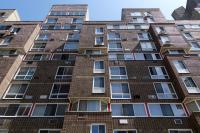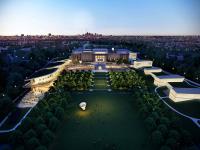North Slope Court House
Machida, Tokyo, Japan
The site is an untouched sloping site with no trace of the original building. When we visited the site, which slopes down to the northeast, we felt two things. The first was the "difficulty" of moving the soil and the complexity of the legal regulations due to the slope and the high grade slope. The other was a certain "anticipation" for an architecture that would softly catch the sunlight from the top of the site, even though the plan itself was difficult because the site was not sloping down to the south.
The relationship between the ground surface and the volume (level) of the building was considered throughout the design process, which was expected in the "difficulties" section, but it was a work of endlessly exploring the very last possibility (for example, the FL of the private room on the second floor south side is lowered to secure the head clearance of the cross corridor). (For example, the FL of a private room on the south side of the second floor is lowered in order to secure head clearance for a cross corridor.)
In order to cut through the sloping site and create a floor for living space, it is necessary to build a retaining wall to hold back the earth. The theme of this project was how to design the retaining wall and the architecture as "one and the same". In reality, there is a considerable distance between the function of the retaining wall and that of the wooden structure above ground. The concrete wall is subject to earth pressure and the wood-frame "house" is subject to earth pressure. As I studied the relationship between the two, I realized that it is in the "in-between" that the clues lie. When the "ma" is opened up and a courtyard-like hanging garden is placed, soft light and wind pouring from the upper part of the site will be brought into each living space, and a relationship will be established where people can feel each other's presence and live together. We thought that by arranging the private rooms on the south side and the courtyard between them, the depth would not be too great, and a sense of "living together" would be created by facing each other.
In order to blur the sense of territory, the wooden exterior wall and the retaining wall are finished with the same painted wall, and a custom-made full-opening sash is used on the living room side. This extends the territory and creates a sense of volume that exceeds the building coverage ratio.
The site is long from north to south. The staircase runs from the entrance in the basement to the second floor in a straight line, as if to convey the fact that the cross section of the house is three stories high. The long distance that one feels here also contributes to the sense of the size of the house. Light is guided through the staircase so that it feels like a "garden" within the interior space.
While arranging the various rooms as needed, the relationship between them was built up. By intervening "ma" in the process, I feel that the architecture itself has a pulling force that spins it into a single textile.
- Architects
- Takeshi Hirobe Architects
- Location
- Machida, Tokyo, Japan
- Year
- 2015
























